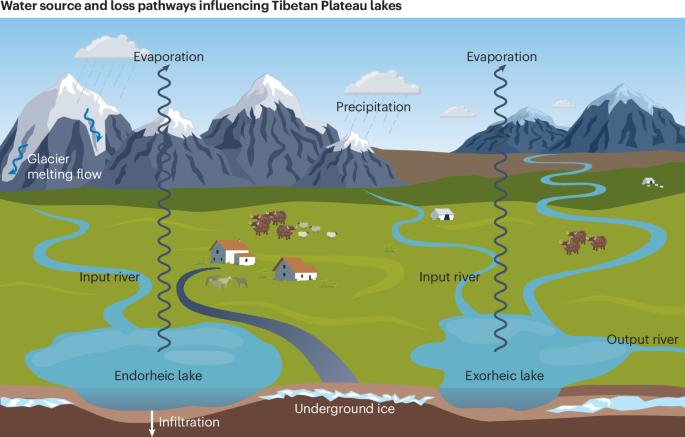Physical and biogeochemical responses of Tibetan Plateau lakes to climate change
引用次数: 0
Abstract
The lakes, rivers and glaciers of the Tibetan Plateau (TP) — a vital water resource for East Asia — are undergoing substantial environmental change. In this Review, we examine trends in the size and the physical and biogeochemical properties of TP lakes. Lake area and volume have consistently increased since 1995, with most rapid expansion in northern lakes. Between 1986 and 2022, the total area of lakes larger than 1 km2 increased from 37,109 km2 to 46,980 km2, and water storage increased by 169.7 km3, driven by warming and enhanced precipitation. In large lakes (≥10 km2), average surface temperatures increased by 1.33 °C, water transparency increased by 1 m, and salinity decreased from 48.76 to 23.76 psu. Responses in lake biogeochemistry include enhanced microbial diversity and trophic status, despite minimal additional nutrient inputs and consistent rates of productivity. Although TP lakes appear to be a net source of CO2 to the atmosphere (1.60, 6.87 and 1.16 Tg C yr−1 in the 2000s, 2010s and the 2020s, respectively), long-term CO2 source-sink dynamics remain uncertain. TP lake area is projected to increase by 9,000 km2 by 2050 under SSP5-8.5 and will continue to influence and enhance regional precipitation. Improved prediction of TP lake hydrology and biogeochemistry will aid sustainable management of water resources across the TP. Climate change affects Tibetan lakes through its influence on precipitation, glacial meltwater flux, and permafrost degradation. This Review discusses the observed response of the physical and biogeochemical properties of lakes, including salinity and trophic complexity, to changes in lake size and looks towards future priorities in lake monitoring and modelling.

本文综述了青藏高原湖泊规模、物理和生物地球化学特征的变化趋势。自1995年以来,湖泊面积和体积持续增加,北部湖泊扩张最快。1986 ~ 2022年,受气候变暖和降水增加的影响,1 km2以上湖泊总面积从37109 km2增加到46980 km2,蓄水量增加169.7 km3。大型湖泊(≥10 km2)平均地表温度升高1.33℃,水体透明度升高1 m,盐度从48.76 psu降至23.76 psu。湖泊生物地球化学的响应包括微生物多样性和营养状况的增强,尽管很少有额外的营养投入和一致的生产力。虽然TP湖似乎是大气CO2的净来源(2000年代、2010年代和2020年代分别为1.60、6.87和1.16 Tg C - 1),但长期CO2源汇动态仍不确定。在SSP5-8.5情景下,预计到2050年TP湖泊面积将增加9,000 km2,并将继续影响和增强区域降水。改进青藏高原湖泊水文和生物地球化学预测将有助于整个青藏高原水资源的可持续管理。本文讨论了湖泊物理和生物地球化学特征(包括盐度和营养复杂性)对湖泊大小变化的响应,并展望了湖泊监测和建模的未来重点。
本文章由计算机程序翻译,如有差异,请以英文原文为准。
求助全文
约1分钟内获得全文
求助全文

 求助内容:
求助内容: 应助结果提醒方式:
应助结果提醒方式:


